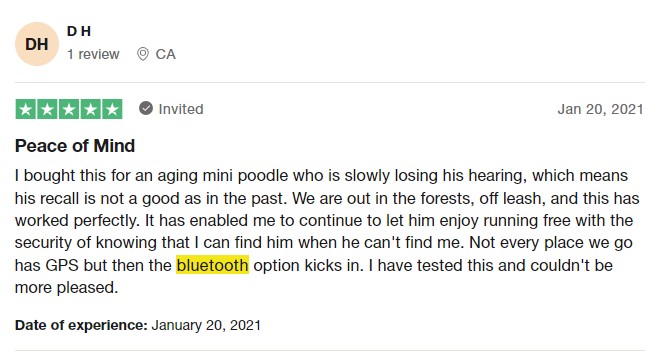GPS vs Radio Frequency: How Do They Compare For Pets?
Radio frequency pet trackers make for affordable tracking options - but for max security and 100% peace of mind, you're better off with a dedicated pet GPS tracker. Here's why.
As a loving dog or cat parent, you might’ve searched pet trackers online – and come across a radio frequency pet tracker as one option. But what even are radio frequency pet trackers – and how do they work?
Short answer: radio frequency trackers might not be the best choice for pets. Their limited range, frequent obstructions, and lack of pet-friendly features fall short of modern GPS dog and cat trackers. Here’s a deep dive why – and how investing in the Tractive smart tracker could end up saving your pet’s life.

Find out where your cat spends their time.
Read more- What is radio frequency?
- What are radio frequency tracking devices?
- Is radio frequency safe for pets?
- How do radio frequency trackers work? The pros & cons
- Can radio frequency pet trackers track in real-time?
- Don’t GPS trackers need cell coverage to work?
- How about if I want to find my dog or cat indoors?
- User review of radio frequency pet trackers
- So, how does a radio frequency pet tracker compare to GPS?
What is radio frequency?
Bear with us for a moment – this is going to get technical. Radio frequency (RF) refers to the fluctuation of electromagnetic energy within a certain frequency, namely 3 kilohertz (kHz) to 300 gigahertz (GHz).
Here is a more detailed definition of radio frequency from the Federal Communications Commission (FCC) :
“Electromagnetic radiation consists of waves of electric and magnetic energy moving together. Radio waves and microwaves emitted by transmitting antennas are one form of electromagnetic energy, collectively referred to as “radiofrequency” or “RF” energy or radiation.“
Source: RF Safety FAQ
📻 Basically, it’s what lets you sing along to your favorite tunes on your local radio station. So how does radio frequency play a role in tracking devices?
What are radio frequency tracking devices?
Radio frequency trackers (RF trackers) are tracking devices that use radio frequency to send and receive information between two components. (Usually for location tracking purposes.) So with a radio frequency tracker, you might have to use a separate receiver – like a handheld locator device. Which you’ll have to carry around with you everywhere to locate your pet in case they wander off. (Sounds pretty cumbersome, if you ask us!)
💡 On the other hand, GPS trackers like Tractive use a combination of other tracking technologies like Bluetooth, GPS, cellular and satellite. All of which connect to your phone or tablet – so you can track your missing with complete peace of mind…and just a glance at your device.
“Your Tractive device’s GPS module receives signals from several GPS satellites. This helps it better and more accurately calculate your pet’s position. These satellites then forward their location to the Tractive servers with the help of the network module. (Which also includes a SIM card.)
Once the Tractive servers receive this information, you can quickly and easily check your pet’s location when you open the Tractive app.”
– Ivelin Nenkov, Embedded Systems Engineer at Tractive since 2016
Is radio frequency safe for pets?
Here’s what a 2021 study found: any radiation exposure as a result of a radio frequency tracker was well below international limits.2 That means negative health reactions in pets or humans are unlikely. So just like cell phones are considered safe for human use, radio frequency devices are considered safe for pets.3
In fact, using radio frequency technology in household products is nothing new. It’s an essential component of your television, computer, phone, radio and even remote-controlled toys. So if your dog or cat doesn’t mind those, they likely won’t mind a radio frequency pet tracker.
How do radio frequency trackers work? The pros & cons
Some companies make radio frequency trackers specifically for pets. The radio frequency locator typically comes with one remote and one or more tags, which you can attach to your pet’s collar. As our friends at The Nomad Cats explain:
“It works like a compass: You need to be within a (claimed) distance of 130 meters to pick your cat’s location.
A light and / or sound will then increase or decrease to indicate how close you are to your cat.”
– Martina, The Nomad Cats
 Pros
Pros
- Small size
- One-off cost, no subscription fee
- Not dependent on cellular network or GPS
- Long lasting battery: Up to one year
- Accurate (within a short distance)
 Cons
Cons
- Limited range
You can only detect your pet’s location within a radius of 426 ft (130m). Some radio frequency pet trackers like Marco Polo have a range of around 2 miles (3 km). Which still might not be enough if you’ve got an active pet who likes to be on the move often. - No real-time tracking
Which, in an emergency, might even end up saving your pet’s life. - Frequent obstructions
Trees and other natural or man-made obstacles can decrease the functional distance of the radio frequency tracker. - No back up localization option
You’re out of luck if you can’t pick up your pet’s location signal – especially in remote areas. - Limited device compatibility
Most radio frequency trackers might require you to use a separate receiver, like a handheld locator. They don’t connect to your phone or other devices like most GPS trackers do.
Can radio frequency pet trackers track in real-time?
Not always. Most “pure” radio frequency trackers don’t offer reliable real-time tracking. Rather, at best, they offer directional guidance and how close or far you might be from your pet while searching.
On the other hand, some radio frequency pet trackers that combine radio frequency with GPS can, however, offer real-time tracking – but only up to a certain range. For example, the Marco Polo pet tracker might offer real-time distance updates once you’ve triggered the Lost Pet feature. And even then, you’re still stuck to a range of just about 2 miles (or 3 kilometers.) Others, like the Garmin Astro 430, use a mix of radio frequency and GPS to extend to a range of around 9 miles (or 14.5 km), up to which you can track your pets in real-time.
Which could still work if your pets don’t tend to stray too far. But just for reference, most cats wander around 344 yards/315 meters away before someone notices they’re missing.5 And that’s assuming they haven’t run into something dangerous before you do start looking for them. Even small dogs can run off up to a half mile (~1 km) – simply because they’re bored.6 Bigger dogs can cover even longer distances – up to 5 miles/8 km!
So why track your pets if you can only track them so far?
Don’t GPS trackers need cell coverage to work?
Yes, for the most part. But your Tractive GPS includes features that save your pet’s locations, even in areas with poor cell coverage. Like, for example, Location History.
“If you want to pinpoint your pet’s location or store their Location History, you don’t actually need a cellular connection.
So once you’ve equipped your Tractive GPS, there’s no need to worry if your device loses coverage for a little while. Your tracker stores your pet’s positions securely. So you’ll be able to see where they’ve been even if you’re offline.”
– Ivelin Nenkov, Embedded Systems Engineer at Tractive since 2016
💡Which, in the long run, helps you pick up on where your pets tend to wander off to the most. Helping you better understand their behavior – and pre-empt an escape attempt.
How about if I want to find my dog or cat indoors?
This is where a short-range radio frequency or even a Bluetooth tracker can come in handy. Since they can help you locate your pet in areas where GPS isn’t the most helpful – like the indoors. Plus, smaller dogs and cats can end up in some risky hiding spots! Like, for example:
- Washers and dryers,
- High rafters, where they can’t climb down,
- Garages, where they might end up hidden under a car or low shelf, where you can’t see them,
- Bigger wardrobes, where they might end up tangled up in your winter coats
- …or just about anywhere indoors, where they might get stuck and unable to call out for help.
😉 But in case that’s turned you off GPS, think again. Tractive devices come equipped with both GPS AND Bluetooth tracking – so you can locate your dog or cat at short-range or in an indoor environment, where GPS isn’t as helpful. Check out how our short-range Radar Mode works – using your phone’s Bluetooth to guide you in the direction of your pet at short range.

User review of radio frequency pet trackers
At first, when Martina (who runs The Nomad Cats) received her first radio frequency cat tracker, she tried it out immediately on her feline buddies. It worked generally well outdoors – but only when the cats didn’t venture too far from home. However, one time, things didn’t go so great.
“When Milù went missing, I scouted the immediate and not-so-immediate surroundings day and night, pointing the remote in every direction, hoping to pick up her signal.
Nothing. Nothing, for miles, and miles after that. Because I had no idea which direction she took off, the task was overwhelming.
On top of that, the amount of trees and other natural obstacles significantly decreased the distance the locator could cover.
And because we like to spice things up with as much bad luck as possible, the remote broke.”
Source: Cat Trackers: Radio Frequency vs GPS
So, how does a radio frequency pet tracker compare to GPS?
When it comes down to picking the best choice for a pet, you’re best off with a dedicated pet GPS tracker that helps you track in real-time with LIVE Mode and find your pet over an unlimited range. Here’s a quick summary of the differences between most radio frequency trackers – and how they compare to a GPS tracker that’s, well…actually designed for pets.
| Radio frequency pet trackers | Tractive GPS Tracker | |
| Range | Up to 9 miles (14.5 km) | Unlimited |
| Real-time updates | Not with “pure” radio frequency trackers. (Only if combined with GPS.) | |
| Weight | 6-7 g (0.2-0.3 oz) | Dogs: 39 g / 1.2 oz Cats: 25 g / 0.9 oz |
| Waterproof | Not consistently | |
| Battery life | Up to 6 months (sometimes more, depending on the brand) | Up to 10 days, up to 1 month with XL |
| Upfront cost | ~$100+7 | $69 + subscription fees at the price of a coffee and cookie per month |
| Ongoing costs | None | Monthly plans priced lower than your Netflix subscription |
| Area of operation | Worldwide | Worldwide |
| Activity & Sleep tracking | ||
| Health alerts | ||
| Light & Sound tracking | ||
| Bluetooth tracking |
While radio frequency trackers have some pros like low cost and long battery life, their cons overwhelmingly outweigh these. Their biggest downsides? A lack of real-time tracking and limited range. So if your pet roams too far from you, a radio frequency tracker (like most Bluetooth trackers for pets) will be useless. Not to mention, you won’t even know which direction to start your search. On top of that, physical obstacles can block the RF tracker’s signal. And that makes it difficult to locate your pet when you need to most.
So in a nutshell: radio frequency trackers might be a good option for pet parents who are sure that their buddy won’t stray too far from their side.
😺 However, isn’t the whole purpose of a pet tracker to be able to find your dog or cat if they really do get lost and run away? Like, lost lost. (Like, say, on vacation – in an unknown city or country – where you can’t stay forever to find them.) In fact, why track your pet at all if you can only track them so far?
That’s where GPS trackers for pets come to the rescue.




